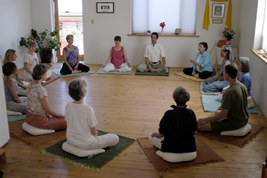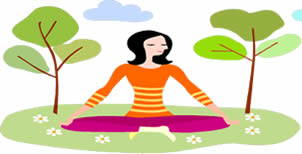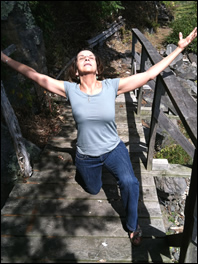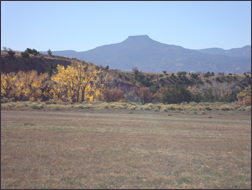 If you attended my yoga classes, you probably have had the experience of chanting a word or words in Sanskrit. The words I would have chosen for us to chant would have supported the focus for the class. For example, if we were focusing on the concept of “peace,” we would chant the Sanskrit word for peace, “shanti,” and allow that sound to help create a sense of peace in our bodies, our breath, our minds, and our hearts.
If you attended my yoga classes, you probably have had the experience of chanting a word or words in Sanskrit. The words I would have chosen for us to chant would have supported the focus for the class. For example, if we were focusing on the concept of “peace,” we would chant the Sanskrit word for peace, “shanti,” and allow that sound to help create a sense of peace in our bodies, our breath, our minds, and our hearts.
Because of my love of chanting and my desire to learn more, I spent ten days in May, 2013 in the 2nd module of a two year training in Santa Fe, New Mexico, focusing on Vedic Chant. The word “Vedic” comes from the noun “Veda,” meaning “knowledge” in the Sanskrit language. The Vedas, which are about 4,000 to 5,000 years old, are a collection of chants, poems, rituals, hymns, and mantras in Sanskrit passed generation to generation through chanting. What we chant from the Vedas is Vedic Chant, learned with attention to rhythm, meter, and pronunciation. The chants are pleasant to hear and chant. The sound of the chants has the potential to influence our entire system. Many of the chants are about Nature, health, and healing and can help bring about positive change for us.
In our ten days of Vedic Chant training, we chant a lot in small and large groups, receiving instruction and feedback from chanting teachers. We also study the Sanskrit language and the context and meaning of chants. When we finish the ten days, we chant and study on our own, seeking others who might also study Vedic Chant or requesting help from a teacher, often via Skype or phone.
I can’t tell you how many times I am asked why I am studying Vedic Chant or what I want to do with it. The answer to the first question is that I love the sound of the chants. I love the focus on Nature. I love that I am part of a group seeking to assure that Vedic Chant will continue to be passed on. I know the sound of the chants are special: they move energy; they support health; they heal.
The answer to the second question is that I hope to create a community of people who want to learn, experience, enjoy, and benefit from Vedic Chant. As I complete my training next year, I look forward to sharing my love of chant with you.
~

 No, I am not a thief, but…
No, I am not a thief, but… “You have to say ‘no’ to what you don’t want in order to be able to say ‘yes’ to what you do want.” My yoga teacher, Fran Ubertini, told me this almost every time we met in our private sessions. It took me a long time to grasp what she really meant and apply it in my life.
“You have to say ‘no’ to what you don’t want in order to be able to say ‘yes’ to what you do want.” My yoga teacher, Fran Ubertini, told me this almost every time we met in our private sessions. It took me a long time to grasp what she really meant and apply it in my life. I was so moved by the message given in the Ash Wednesday service I attended this year that I had to share it with you. In the past the messages I heard this time of the year were about “giving up” something – like chocolate or coffee shops or sweets or movies – as in letting go of something we enjoyed.
I was so moved by the message given in the Ash Wednesday service I attended this year that I had to share it with you. In the past the messages I heard this time of the year were about “giving up” something – like chocolate or coffee shops or sweets or movies – as in letting go of something we enjoyed.  The greatest gifts of yoga for me have been the reduction of suffering in my life and the ability to experience joy. On a physical level, I have experienced pain from problems with my spine, which my yoga practices have helped me to manage so they do not debilitate me. But my greatest vulnerability has been a susceptibility to anxiety and depression. At its worst, I experienced panic attacks and debilitating depression.
The greatest gifts of yoga for me have been the reduction of suffering in my life and the ability to experience joy. On a physical level, I have experienced pain from problems with my spine, which my yoga practices have helped me to manage so they do not debilitate me. But my greatest vulnerability has been a susceptibility to anxiety and depression. At its worst, I experienced panic attacks and debilitating depression.